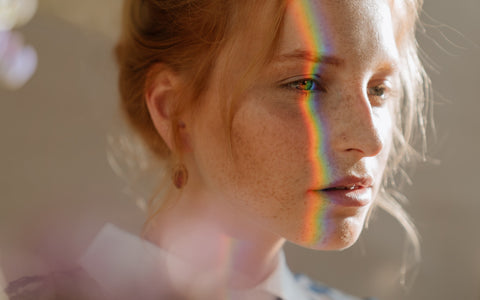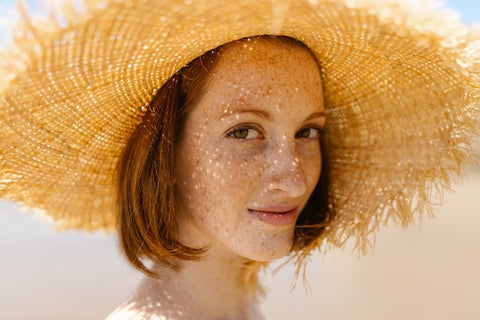
Freckles and sunspots are common skin concerns that many people encounter at some point in their lives. While they may share some similarities, they are fundamentally different in their origins, appearance, and treatments.
In this article, we'll delve into the distinctions between freckles and sunspots. Let's explore their causes, treatment options, and address questions you might have concerning either of them.
What are Freckles and Sunspots?
Freckles are small, flat, pigmented spots that appear on the skin, particularly on areas exposed to the sun. They are often tan, light brown, or red in color and can vary in size. Freckles are typically harmless and are more common in individuals with fair skin, light hair, and light eyes.
Interesting Fact: Freckles are often hereditary. If your parents or grandparents had freckles, you're more likely to develop them as well.
Sunspots, also known as age spots or liver spots, are dark, flat, and round or oval-shaped patches that develop on the skin. Unlike freckles, sunspots are more likely to appear as you age. They are typically brown, black, or gray in color and can vary in size. Sunspots are damage caused by prolonged sun exposure and are more common in individuals with fair skin.
How Do You Tell the Difference Between Freckles and Sunspots?
Distinguishing between freckles and sunspots can be challenging since they may appear similar at first glance. However, there are several key differences that can help you tell them apart:
1. Appearance:
Freckles are typically small, round or oval, and flat. They can vary in color but are often tan, light brown, or red. Freckles are generally uniform in color and size and may become more pronounced with sun exposure. Sunspots, also known as age spots or liver spots, are usually larger and darker than freckles. They are often brown, black, or gray in color and tend to be more irregularly shaped. Sunspots can also vary in size but are generally larger than freckles.
2. Location:
Freckles often appear on areas of the skin that are regularly exposed to the sun, such as the sun, such as the face, shoulders, arms, and upper back. They can also develop on any part of the body. Sunspots are most commonly found on areas that have received significant sun exposure over the years, such as the face, hands, arms, chest, and shoulders.
3. Age of Onset:
Freckles can develop at any age, including childhood, and tend to become more noticeable during periods of increased sun exposure, such as summer. Sunspots typically appear later in life, often after the age of 40, as a result of cumulative sun damage.
4. Cause:
Freckles are primarily caused by genetics and an overproduction of melanin in response to sun exposure. They are more common in individuals with fair skin, light hair, and light eyes. Sunspots are primarily the result of long-term sun exposure. UV radiation from the sun triggers the accumulation of melanin in specific areas of the skin, leading to the development of sunspots.
5. Response to Sun Exposure:
Freckles tend to darken when exposed to the sun and may fade or lighten in the absence of sun exposure. Sunspots do not typically change in response to sun exposure and may persist or become more pronounced over time.
What Causes Freckles and Sunspots?
Freckles result from an overproduction of melanin, the pigment responsible for skin, hair, and eye color. When your skin is exposed to the sun's ultraviolet (UV) radiation, it triggers the melanocytes (melanin-producing cells) in your skin to produce more melanin. Freckles are essentially clusters of melanin that become more pronounced when you're exposed to sunlight.
Sunspots, on the other hand, develop due to accumulated sun damage over time. UV radiation from the sun accelerates the production of melanin in certain areas of the skin. Unlike freckles, sunspots are not the result of an overproduction of melanin but rather an uneven distribution of melanin due to sun exposure over the years.
Treatment Options for Sunspots and Freckles
While all skin is beautiful some blemishes can make people self-conscious, and everyone has the right to feel confident in their skin. But don't worry, both sunspots and freckles can be treated, although the approaches differ.
Freckles
Sunscreen: The best way to prevent freckles is to wear a quality, broad-spectrum SPF whenever you're exposed to the sun. This not only protects your skin from harmful UV rays but also prevents freckles from getting darker.
Topical Lightening Creams: Over-the-counter or prescription creams containing ingredients like hydroquinone, retinoids, or alpha hydroxy acids can help lighten freckles over time.
Laser Therapy: In some cases, laser therapy can be used to target and remove freckles. This should be done by a dermatologist or a trained skin care professional.
Sunspots
Sunscreen: As with freckles, sunscreen is crucial to prevent further sun damage and darkening of sunspots.
Topical Lightening Agents: Dermatologists may recommend prescription creams containing ingredients like hydroquinone, tretinoin, or glycolic acid to lighten sunspots gradually.
Chemical Peels: A dermatologist can perform chemical peels to exfoliate the outer layer of skin, reducing the appearance of sunspots.
Laser Therapy: Laser treatments, such as intense pulsed light (IPL) therapy or fractional laser therapy, can effectively target and remove sunspots.
Commonly Asked Questions

Do People with Freckles Need More Sun Protection Than Others?
Yes, people with freckles are generally more susceptible to sunburn and sun damage. The presence of freckles is often an indication of a skin type that produces less melanin, providing less natural protection against UV radiation. Therefore, it's essential for individuals with freckles to take extra precautions when in the sun, including wearing sunscreen, protective clothing, and seeking shade.
Are Sunspots or Freckles Harmful?
Neither sunspots nor freckles are inherently harmful. However, they are both indicators of sun damage, which can increase your risk of skin cancer. It's crucial to monitor any changes in the size, color, or texture of these spots and consult a dermatologist if you notice any concerning developments.
How Do I Protect My Skin from Sunspots?
- Use Sunscreen Daily: Apply a broad-spectrum sunscreen with at least SPF 30 or higher every morning and reapply every two hours, even on cloudy days.
- Wear Protective Clothing: Opt for long sleeves, wide-brimmed hats, and sunglasses to shield yourself from UV radiation.
- Seek Shade: Whenever possible, stay in the shade, especially during peak sun hours between 10 a.m. and 4 p.m.
- Avoid Tanning Beds: Artificial tanning devices can also contribute to sun damage and increase the risk of sunspots and skin cancer.
Does Sunscreen Prevent Freckles?
Yes, sunscreen can effectively prevent freckles. The key is to use sunscreen consistently and generously, even on days when you don't plan to spend much time outdoors. The sun's UV radiation can still reach your skin through windows and on overcast days, so it's essential to make sunscreen a part of your daily skincare routine.
So, while freckles and sunspots are not harmful in themselves, they both indicate significant sun exposure and an increased risk of skin cancer. In this way, they both serve as reminders of the importance of sun protection.
By adopting a diligent sun protection routine and seeking professional advice when needed, you can keep your skin healthy and glowing. Remember, your skin is your body's largest organ, so treat it with care and protect it from the sun's harmful rays.


